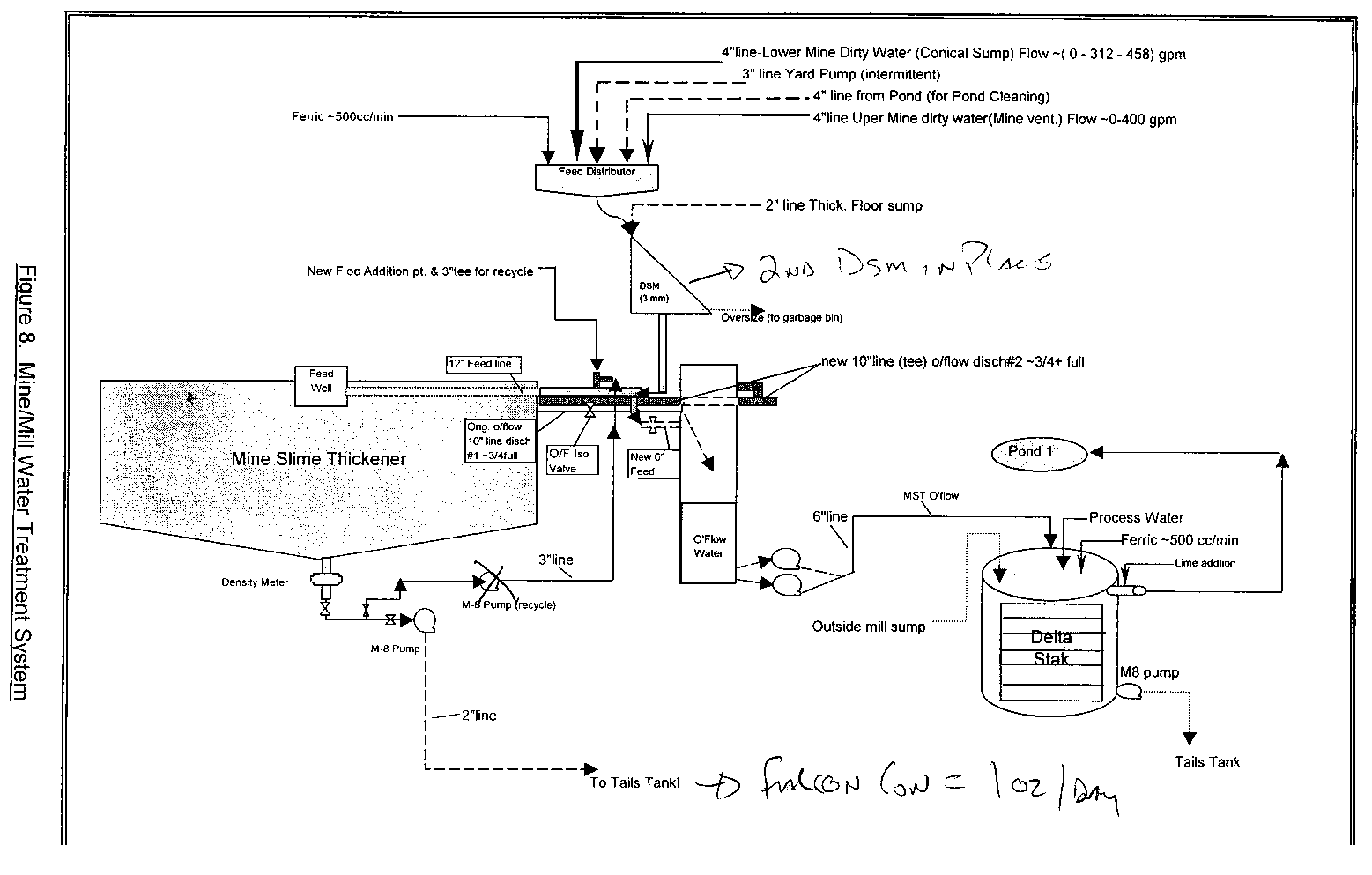The Eskay Creek Mine is located in north-western British Columbia approximately 83 km north-west of Stewart, B.C. as shown in the location map Figure 1. A restricted access 59 km long gravel road, shown in Figure 2, from Bob Quinn Lake junction of highway 37 provides road access to the site. The employees at the mine typically work a two-week on two-week off rotation, or a four-week on two week off rotation. Employees are flown to Smithers by commercial airlines or chartered aircraft and then from Smithers to the Bob Quinn airstrip by the owned twin otter aircraft. During poor weather conditions, transportation to site is by company vans, which take about five hours to travel the 450 km road distance. The minesite includes a 300-person camp, recreational facilities, full-service kitchen, warehouse, backfill plant, ore storage, and diesel power plant amongst other infrastructure.
Eskay Creek History
In 1932, a syndicate directed by Tom Mackay explored and identified more than 30 mineral showings in the Iskut River region. It was not until 1988 that a small joint venture drilled Eskay’s “high-grade 21 Zone”, after which higher and higher-grade areas were discovered. Eventually, senior mining companies became interested and International Corona prevailed as majority owner. In 1991 Prime Resources Group Inc. obtained 100% ownership of Eskay Creek.
In 1993, after the project feasibility study had been approved, Prime began the engineering for the Eskay Creek Project. The feasibility study had outlined a mineable reserve of 1.1 million tonnes grading 65.5 g/t gold and 2,930 g/t silver. The metallurgical testwork for the feasibility study had defined a very complex hydro-metallurgical flowsheet for the recovery of gold, silver, copper and zinc. This process was complex and expensive, requiring a large capital outlay with high unit operating costs. The original operating plan was to construct the mining infrastructure at the mine site and transport the ore to a processing facility located close to Placer Dome’s Equity Silver Mine, near Houston, B.C. With the complexity of the ore and the type of treatment process, one of the concerns was permitting for tailings disposal.
Prime continued to evaluate other processing options during the mine development program. Smelters were identified in both Japan and Canada that were interested in treating the whole ore unprocessed directly from the underground mine. Early in 1994, the decision was made to ship the ore directly from the underground mine to smelters and not build the processing plant at Houston, B.C. Necessary changes and modifications were made at the engineering stage to include crushing and ore storage facilities at the minesite.
In late 1994 Mining operations commenced at Eskay Creek. The mine was operated on behalf of Prime by Homestake Mining Inc., which owed 51% of Prime. Continued exploration in 1995 and 1996 identified the NEX ore zone and expanded the 109 zone. These zones are a lower grade and contain lower amounts of deleterious minerals, than the ore being shipped directly to the smelters. With the high cost of direct shipping and smelting, a large portion of this material would be uneconomical. It was recognised early that some type of on site or local processing was needed to improve the economics of the 109 and NEX zones. In 1996, a testwork program was initiated at Process Research Associates with follow up locked-cycle testing at International Metallurgical and Environmental Inc. to evaluate the potential of a gravity/flotation process for upgrading ore from the NEX and 109 zones into marketable concentrates. The work indicated that the ore could be economically upgraded into a sellable concentrate.
In 1997, Prime completed the engineering and construction of a 150 tonne per day mill to concentrate the gold and silver values for the NEX and 109 zones. Over the next several years, the mill has been steadily upgraded and expanded to its current production level of 350 tonnes per day.
In 2002 Gold Inc. became sole owner and operator of Eskay Creek through its merger with Homestake Mining Inc. The merger created one of the world’s largest Gold Mining Companies with operations and projects located around the world.
Eskay Creek Orebody Description
Presently, there are 8 different gold-silver bearing zones outlined at the Eskay Creek Mine. A detailed description of all 8 gold-bearing zones is listed in Figure 3. At this time mining is being done in only 6 of the zones described below. They are listed in order of contained ounces.
21B Zone: Stratiform bedded sulphides and sulphosalts with disseminated high-grade gold, electrum and silver in tetrahedrite. Sulphides include galena, sphalerite, stibnite, pyrite, realgar and cinnabar. Sulphosalts include tetrahedrite-freibergite and Pb- sulphosalts such as boulangerite, bournonite and jamesonite. Some fringe areas are millable; majority of ore is shipped to smelters.
HW Zone (Hanging Wall): Massive, fine-grained stratabound sulphide lenses dominated by pyrite, sphalerite, galena, as well as chalcopyrite and tetrahedrite stringers. This zone has generally lower Au-Ag grades and higher base metals relative to 21B zone. Zone contains lower grade areas, which are millable.
21C Zone: Bedded massive to bladed barite associated with very fine-grained disseminated sulphides including pyrite, sphalerite, terathedrite and galena. Underlain by localized zones of cryptic, disseminated, precious metal bearing mineralization in the rhyolite. Zone contains lower grade areas, which are millable.
NEX Zone: Massive to locally clastic bedded sulphides and sulphosalts of the similar type as 21B zone. Has fewer sulphosalts and local overprint of chalcopyrite stringers. High grade Au-Ag. Ore is 90% millable and 10% shipped directly to smelter.
109 Zone: Stockwork veins of quartz within rhyolite (flow banned, brecciated) including galena, sphalerite, pyrite and visible gold associated with silica flooding and fine grained amorphous carbon alteration. Lower than 21B and NEX Au-Ag grades. Zone contains ore, which is primarily millable.
Pumphouse & Pathfinder Zone: Veins of pyrite, sphalerite, galena, and tetrahedrite. Commonly bonded; locally with colloform textures. Local zones of very fine-grained mineralization in rhyolite. Zone contains some millable areas.
Present Milling Process
Overview
The mill is designed to treat complex high-grade gold and silver-bearing base metal sulphides, primarily galena, sphalerite, tetrahedrite and pyrite. Free gold is recovered by gravity separation, while residual gold, silver in tetrahedrite and most of the floatable base metals are recovered as a bulk flotation concentrate. Figure 4 provides a flowsheet of the unit processes for the Eskay Creek Mill. Figure 5 shows the Key Operating Statistics for the Mill. A detailed Equipment List for the Mill is summarised in Figure 6.
Unit processes consist of:
1. Crushing
2. Grinding and size classification
3. Gravity recovery
4. Flotation with one cleaning stage
5. Dewatering of concentrate and tails
6. Tails deposition
7. Water treatment
Crushing
Primary and Secondary Crushing Plant
The primary crushing facility includes a two stage crushing process to produce a 2” minus product suitable for direct shipment of the ore from the mine to the smelters. Run-of-mine ore is hauled from underground and dumped onto covered fixed grizzly equipped with a hydraulic rock breaker for breaking the oversize. The grizzly openings are 10 inch. Grizzly undersize is reclaimed with a front-end loader and delivered to the primary crushing plant feed hopper. Ore is delivered to the Nordberg C80, 21 inch x 32 inch primary jaw crusher via a vibrating feeder. The jaw crusher product is conveyed to a 50 inch x 144 inch horizontal vibrating screen with 2 inch square openings. Screen oversize discharges directly into a Nordberg HS1010 horizontal impact crusher. Screen undersize and impact crusher discharge are conveyed on #2 conveyor to the three concrete ore storage bins. This conveyor is equipped with belt plows, which are placed manually to direct the ore into one of three storage bins. The bins were constructed to provide the flexibility of blending the ore based on ore type and/or mineral content.
The primary crushing plant is equipped with a pendulum type sample belt cutter, which collects representative samples for metals assay. A weightometer on the conveyor measures the amount of material placed into each storage bin. This information allows for metallurgical accounting by the geologist and marketing group.
Ore Storage and Tertiary Crushing inside Mill
In order to deliver ore to the mill, #2 conveyor is equipped with a belt plow to direct the ore to the transfer conveyor feeding the mill. Milling ore is campaigned from mine through the primary crushing plant to the 150 tonne coarse ore bin via the transfer conveyor and the coarse ore bin feed conveyor.
Ore is removed from the coarse ore bin through a slot discharge using a 36-inch belt feeder. The belt feeder is designed to operate over a range of speeds from 6.8 to 33.4 feet/minute. The bin has been lined with bolted urethane liners to promote material flow. The coarse ore bin discharge feeder transfers the ore to the tertiary cone crusher feed conveyor. The feeder speed is selected manually based on the crusher power draw. The tertiary cone crusher feed conveyor delivers the ore to the Nordberg Horizontal 60-inch x 168-inch vibrating screen where the ½ inch fraction of the ore is sent directly to the fine ore bin, and the coarser remaining portion discharges directly to the Nordberg Omnicone 937 cone crusher. This crusher is equivalent to a 30-inch cone crusher and has a design capacity of 62 tonnes per hour at 10 mm closed side setting (CSS). The crusher is operated in closed circuit with the vibrating screen, where the crusher discharge is conveyed back to the vibrating screen. Screen undersize is transferred to the fine ore bin feed conveyor for transport to the 200 tonne fine ore storage bin.
Grinding
The fine ore bin has twin variable speed 36 inch belt feeders to remove the ore from the bin, and feed the grinding circuit. The fine ore bin has a 200 tonne live capacity.
The ball mill feed belt weightometer controls the belt feeder speed. The set point for the mill feed rate may be varied depending on amount of ore available or ore type. The plant flowsheet has been upgraded for a nominal throughput of 350 tonnes per day but can vary from 200 to 380 tonnes per day. The grinding circuit consists of a single stage ball mill operated in closed circuit with a cyclone. The ball mill is a Marcy 8.5 foot diameter by 12 foot overflow mill utilising a 400 hp motor. The mill is rubber lined and is charged 35% – 40% with 3” steel grinding balls. The Ball Mill feed belt is equipped with a pendulum type sample belt cutter, which collects representative samples for metals assay.
A bank of two 15-inch diameter Technequip hydrocyclones, one operating and one spare, classify the ball mill discharge. Cyclone overflow, flows by gravity to the flotation conditioner tank, while cyclone underflow is split and a portion flows to the ball mill feed with the remaining portion feeding the gravity concentration circuit. The typical work index of the ore is 16.7 kw/mt at a P80 grind size of 85 to 90 microns.
Gravity Concentration
The recovery of gravity gold is significant and results in a higher overall gold recovery than flotation would alone. The gravity gold recovery is dependent on ore type, and ranges from 10% to 30%. To accommodate a gravity circuit in the Eskay Creek mill, the cyclone underflow launder was modified so that a partial stream (60% to 70%) of cyclone underflow could be diverted to the 20 inch Knelson batch concentrator. The remaining portion of the cyclone underflow is sent to the ball mill feed chute for regrinding.
The diverted flow is pumped to a 5 mm sieve bend screen where the undersize feeds the Knelson concentrator. The oversize reports to the ball mill feed chute. The Knelson concentrator operates in a cyclical manner, with cycle times of 60 minutes. The concentrate is discharged to a holding tank, which then feeds the Gemeni 250 shaking table. The tails to from the Gemeni table are sent to final flotation concentrate for dewatering. The very high grade table concentrate is dried, weighed, sampled, and collected in drums for shipment to a refinery operation.
The tails from the Knelson concentrator are pumped to the 4.5 foot diameter x 7.5 foot tall Minnovex flash flotation cell. Dowfroth 250 is added to enhance flotation. Concentrate from the Minnovex flash flotation cell is sent directly to final flotation concentrate for dewatering. The tails from the Minnovex flash cell are sent back to the ball mill.
Flotation
The cyclone overflow reports to the flotation feed conditioner where reagents are added to promote the flotation of the gold, silver and associated sulphide minerals. Depending on the ore type, the total gold recoveries range from 86% to 93%. The recovery of silver minerals in flotation ranged from 90% to 97%. The recovery of base metals; copper, lead and zinc; to the flotation concentrate are also ore dependent and are all expected to range from 80% to over 90%.
The flotation circuit operates at a pH of 7.5 to 7.9 to maximize the recovery of the sulphides. Sulphuric acid is added to the circuit to maintain the pH at the desired setpoint. Staged addition of standard flotation reagents, PAX, 3418A and Dowfroth 250, are used to promote metal recovery.
The flotation circuit is comprised of three, 5 cubic meter Outokumpu tank cells, a single bank of nine, 1.45 cubic meter Minpro flotation cells, and a 4.5 foot diameter x 7.5 foot tall Minnovex contact flotation cell. The circuit is configured with two of the tank cells, the entire the bank of Minpro cells, and the Minnovex contact cell operating as rougher/scavengers, with the third tank cell acting as a cleaner.
The conditioned feed is fed to the two rougher tank cells first, then to the bank of rougher/scavenger Minpro cells and finally to the scavenger Minnovex contact cell. The rougher/scavenger concentrate is sent to the third tank cell, which operates as a cleaner, the concentrate from the cleaner cell reports to the final concentrate thickener. Tails from the cleaner are sent back to the head end of the Minpro bank feeding the Minpro cell bank and Minnovex contact cell. The concentrate from the first two rougher tank cells and the first rougher Minpro cell can be diverted to final concentrate depending on varying ore types and feed grades.
An Outokumpu Courier 30 XP on-stream analyser measures the %Fe, %Zn, %Pb, %Solids, Au g/mt, and Ag g/mt in the flotation feed, final concentrate, final tails, and rougher no. 1 concentrate streams. The results are updated every 15 minutes and displayed for the operators to gauge the metallurgical performance of the circuit.
Concentrate Dewatering
Flotation final concentrate, Falcon concentrate, and tails from the Gemini shaking table are pumped to a 13.1 foot diameter, high capacity, Eimco thickener with an E-Duc feed- well system. Percol-155 flocculant is added to the thickener feed-well to aid in settling of solids. From the thickener a 55% Solid Underflow is pumped to the concentrate stock tank. The concentrate stock tank has the capacity for 6 to 10 hours of concentrate production at nominal plant feed rates. Flotation concentrate production ranges from 65 to 100 tonnes per day, depending on ore type and feed grades. The overflow water from the primary concentrate thickener is directed to a second thickener of the same size. The second thickener acts as a clean-up thickener collecting any residual solids that may have not completely settled and were carried out in the overflow. The overflow from the clean-up thickener is directed to the process water tank and the water is reused in the Mill. Underflow from the clean-up thickener is also sent to the concentrate stock tank.
The concentrate is pumped from the concentrate stock tank to a PF9.5 Larox pressure filter. The filter operates in timed cycles, which include the stages of feeding, air blowing, water pressing and discharge. The cycle times will vary from 11 minutes to 15 minutes depending on ore type. A dewatering aid, Aerodri 104, is added to the concentrate storage tank to improve water percolation during filtration.
Filtered concentrate (11% to 13 %moisture) is discharged onto belt conveyors, which transfer the concentrate to a bagging system where it is fed into super sacks for shipping to the smelter. The super sacks, approx. 2,500 kg when completely filled, are continuously weighed as they are filled and the weights recorded. Samples are taken from each individual bag and assayed. At current production levels, an estimated 30 to 45 bags will be filled per day with flotation concentrate.
Concentrate Transport
The flotation and gravity concentrate products produced from the milling process are shipped to various smelter customers in North America. After the flotation concentrate has been bagged it is loaded onto covered transport trucks, which transport the material 300 km to our warehouse storage facility in Kitwanga. The same transport trucks are also used to truck the Direct Ship Mine to Smelter Ore (DSO) to the Kitwanga facility. At Kitwanga, the flotation concentrate and DSO material are loaded into railway cars for transport to our various smelter customers.
Tailings Deposition
The immediate area encompassing the Eskay Creek minesite does not have sufficient space for a tailings storage pond facility. Therefore, an alternate location 7 km from the minesite was developed and permitted for sub-aqueous tailings deposition. Sub¬aqueous deposition was chosen because the sulphide tailings would not be exposed to oxygen from the atmosphere where generation of acid mine drainage would occur. Sub-aqueous deposition also eliminates the need for continuous treatment of water from the tailings deposition area. Shown in Figure 7, is the Tailings Deposition System.
Flotation tailings are pumped to a 13.1 foot diameter, high capacity, Eimco thickener with an E-Duc feed-well system. Thickener overflow is directed to the process water tank, and thickener underflow at 40% solids is pumped to the tailings stock tank. Percol-155 flocculant is added to the thickener feedwell to aid in settling of solids. The stock tank provides storage for 3 to 5 hours of tailings production at nominal plant feed rates.
The tailings are pumped from the storage tank to the 250 hp Wirth positive displacement pump. The Wirth pump, pumps the tailings 7 km to the McKay Lake deposition area. There are two separate 2.5” ID tailings line, one is in operation, while the other is a spare. At McKay Lake the twin tailings line are joined into one pipeline where the tailings are deposited sub-aqueously 23 meters below the lake surface.
Measurements of water quality leaving the lake are taken on a daily basis. A yearly bathymetric sonar survey of the lakebed is performed to monitor the deposition of tailings.
Water Treatment
All the water used in the concentrating process (approximately 70 to 80 gpm) is collected and sent the to Delta Stak clarifier. In Figure 8, is illustrated the Water Treatment System. At the Delta Stak clarifier, lime and ferric sulphate are added to precipitate the dissolved metals out of solution. The pH of the water along with metals content is continuously monitored prior to feeding the four cleaning ponds. The majority of the precipitates are collected at the bottom of the clarifier and pumped to the tailings stock tank for deposition. Adjustments to pH or ferric addition are made to maintain strict water quality standards in the ponds. Located at Pond #3 are the reclaim pumps, which pump water back to the Mill for reuse. Combined, the four polishing ponds have 20 to 24 hours of residence time, and collect any residue precipitates prior to discharge into the environment. Once a year the ponds are pumped clean, removing any precipitate build-up to increase the pond volume to maximum, thereby increasing the residence time.
Water from the underground mine is also collected and treated prior to discharge into the environment. All water from the mine, and various surface sumps around the minesite are pumped to the Mine Water thickener. Percol-155 flocculant and ferric sulphate are added to the thickener feedwell to aid in settling of solids and precipitates. Thickener overflow is directed to the Delta Stak clarifier for further treatment, and 10% Solids thickener underflow is pumped to the SB 750 Falcon concentrator. The Falcon concentrator recovers any free gold in the underflow material. Concentrate from the Falcon concentrator is sent directly to the final concentrate for dewatering. The underflow material from the Mine Water thickener is sent to the tailings thickener for deposition using the tailings system.
Summary of Mineralization Styles in the Eskay Creek 21 Zone
 Figure 3. Geological Mineralization of Eskay Creek Ore Body
Figure 3. Geological Mineralization of Eskay Creek Ore Body
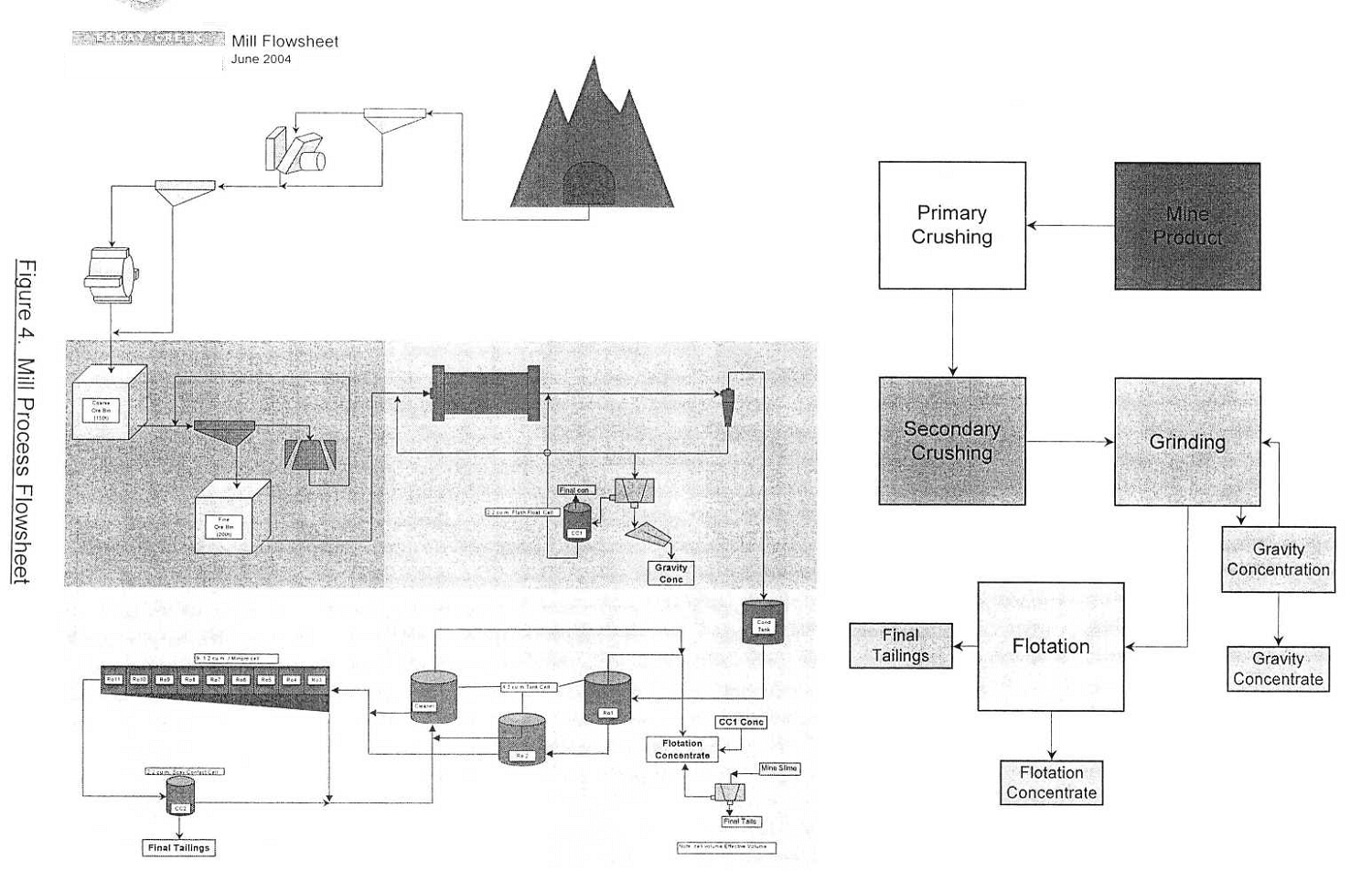
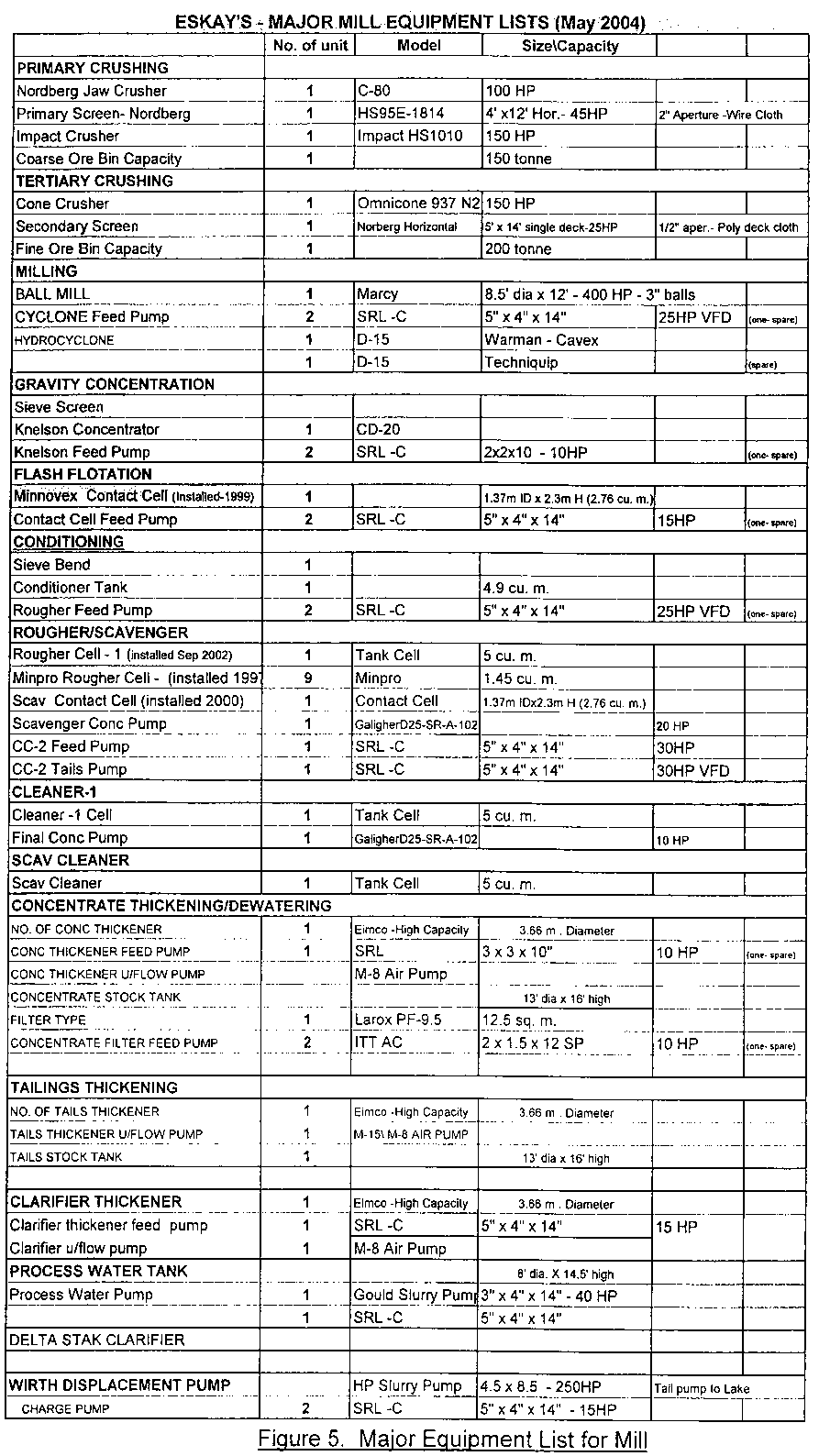
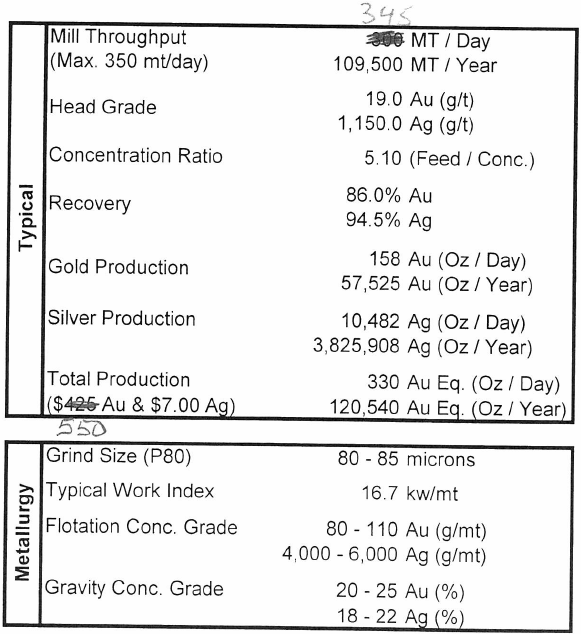
 Figure 6. Key Operating Statistics for Mill
Figure 6. Key Operating Statistics for Mill
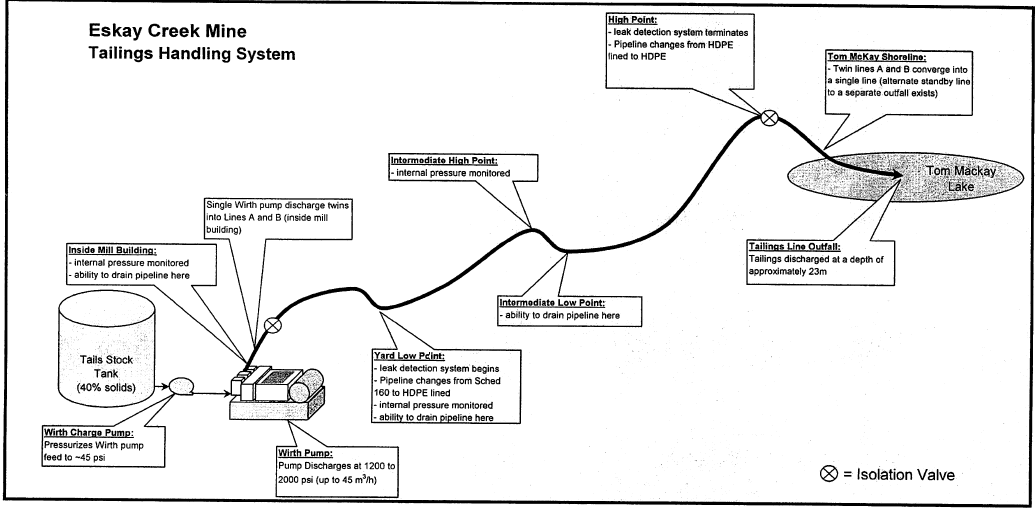 Figure 7. Tailings Disposal System
Figure 7. Tailings Disposal System
